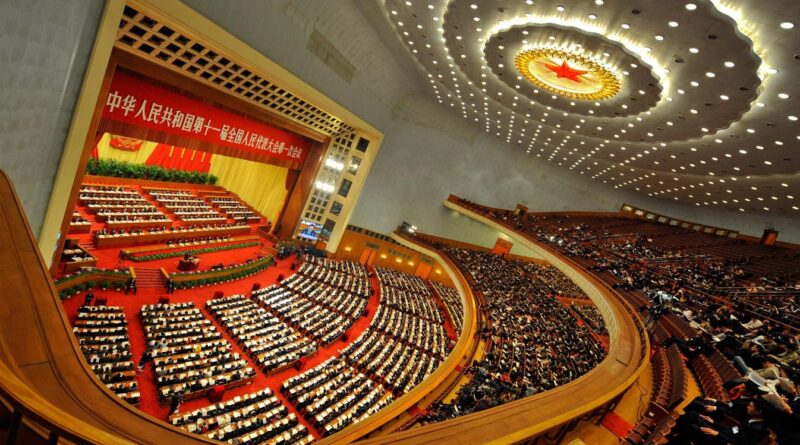A Recurrent Disruptive Process for China’s Economy
One of many meetings where Chinese Communist Party members and representatives decide to do very little … [+]
If China’s sluggish economy didn’t generate some excitement, the trend would seem boringly repetitive. Like many horror movie franchises, the tired formula has been repeated for years now. The economy has shown signs of weakness. Beijing has ignored the problems or introduced inadequate or ill-considered policies. These have failed to correct the problem, and the economy has now given many signs of weakness, which have produced various but still ineffective remedies followed by more signs of economic weakness. It’s starting to look like this approach will not hurt and save poor Chinese income earners and businesses from the pain involved.
Recent news from China confirms the persistence of this trend. During the spring and early summer, the Chinese leadership held a series of large-scale meetings, favored by the Chinese Communist Party (CCP). Each such meeting has announced new policies that should help China regain its economic power. But when the economic issues emerge, it is clear that the policies announced have failed to solve the problems facing the Chinese economy and the country continues to suffer from the loss of energy and growth prospects.
Although all the CCP meetings have confirmed the government’s target which has been reduced to 5 percent of real growth for 2024, every step of the statistics says that the economy is not doing well. According to the National Bureau of Statistics in Beijing, China’s real gross domestic product (GDP) for the first quarter of the year came in at 4.7 percent. Unemployment rose in July to 5.2 percent of the national workforce, up from 5.0 percent earlier this year. The People’s Bank of China (PBOC) reported a sharp decline in bank and other types of loans in July to 770 billion yuan from 3.3 trillion in June. It is the fastest such contraction in two decades. Some of this decline is seasonal, but not all, and shows that households are less inclined to spend on consumer goods or new homes and that Chinese businesses are similarly inclined. of using it to extend the lease.
Every major sector of China’s economy is showing weakness in its own right. The biggest problem is housing. Home sales by value fell nearly 26 percent in July from year-ago levels. The most important thing is how the prices of goods have continued to fall, by 5.3 percent in July from the level of the previous year, than the 4.9 percent recorded in June. The killing occurred despite Beijing’s recent 500 billion yuan effort to fix the problem by buying up vacant apartments.
The decline in commodity prices had a negative impact on consumer spending. Because for many Chinese the value of their home is a large part of their family’s wealth, the drop in home values has made families feel poorer and therefore less financially stable. The result is a huge drag on the economy as a whole. Beijing has tried to boost consumer spending with a program to buy back old home appliances and cars and thus encourage new sales, an Asian version of the “cash for clunkers” program that the Obama administration did not use it in the American recession in 2008. -09. Not surprisingly, the Chinese version had a poor response. As of July, retail sales were only 2.7 percent above year-ago levels, below the overall economic target and down from the growth rate earlier in the year and at the end of last year. .
Meanwhile, business costs have also been reduced. In 2023, the most recent period for which figures are available, private business spending on expansion and modernization increased by just 1.9 percent, which is less than public spending , and is certainly less than China needs to meet its growth targets. Such reluctance is understandable given the generally sluggish and erratic behavior of the economy, but there is more to it. Not too long ago, President Xi Jinping criticized private enterprise owners for pursuing profits instead of the CCP’s agenda. Now that China wants businesses to expand their operations, Xi has changed his approach and has begun praising business owners as “our people.” However, his earlier statements had an effect. Business owners fear, not unreasonably, that he might change his tune and return to his old ways of thinking. That fear has come to a head recently as officials have announced plans to give themselves a bigger role in how to use private business. There is no doubt that private businesses are reluctant to take on more risk.
Exports are also lagging behind. Growth in the rest of Asia boosted overall numbers, but sales in the most important west and Japan were far from encouraging. Governments in Washington, Brussels and Tokyo have shown varying degrees of hostility to Chinese trade, imposing tariffs and other restrictions on shipping. Washington has been very strong in this regard, but it is not the only one. Beyond the hostility of the government, western trade and Japan are willing to diversify their resources away from China. Exports from China to the United States, Europe and Japan all fell from last year’s levels.
Last year, Beijing launched a government investment program in high technology, particularly batteries for electric vehicles (EVs), advanced computer chips, and green energy. In part the authorities have done this to close the gaps in home buying, consumer spending, and private business investment. However, all that effort has been to create excessive power in targeted areas and distort the Chinese economy to produce in areas that the Chinese or the rest of the world do not want from China. Nothing in this picture – either government programs or results – is good. Unfortunately, this trend seems destined to repeat itself into the future, as it has for a long time now.
#Recurrent #Disruptive #Process #Chinas #Economy

